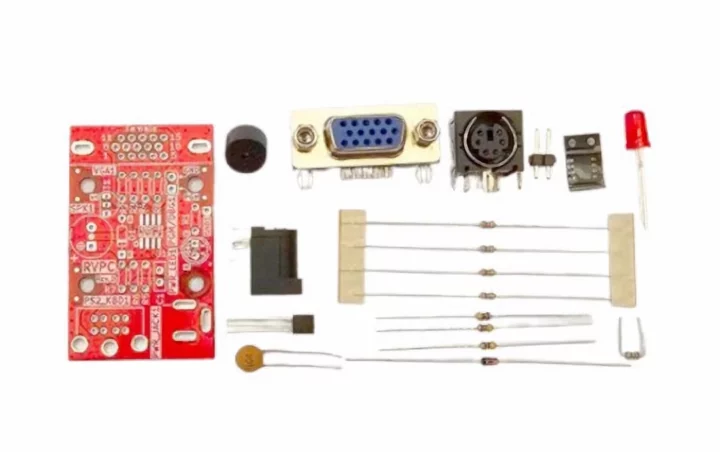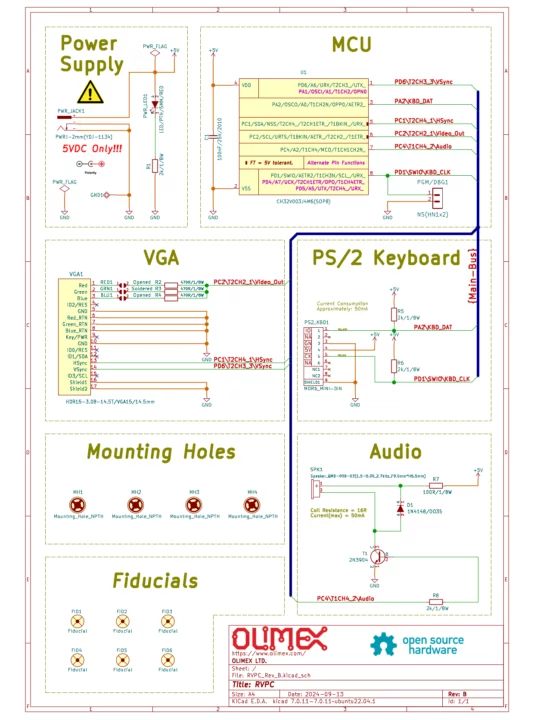Olimex RVPC is one Euro RISC-V computer powered by a WCH CH32V003 RISC-V microcontroller and equipped with a VGA port for video output and a PS/2 connector to connect a keyboard.
You won’t be able to do much with this device as an end-user, but it does not matter since the RVPC open-source hardware board mostly targets the education market and is offered as a kit to be soldered to lower the selling price and to serve as a soldering learning kit.
Olimex RVPC specifications:
- MCU – WCH CH32V003 32-bit RISC-V2A microcontroller up to 48 MHz with 2KB SRAM, 16KB flash (SOP8 package with 6x GPIOs)
- Video Output – VGA connector (3x GPIO used for Vsync, HSync, and RGB)
- Keyboard port – PS/2 connector (2x GPIO used)
- Programmer port – 2-pin header for CH32V003 programming through a board such as ESP32-S2-DevKit-LiPo-USB
- Misc – Buzzer (1x GPIO) and Red power LED
- Power Supply – 5V via power barrel jack
- Dimensions – 50 x 30 mm
- OSHWA certification – BG000142

Programming can be done through PlatformIO IDE and an ESP32-S2-DevKit-LiPo-USB acting as a programmer. Olimex provides several C code samples for VGA output, the audio buzzer, a Tetris demo, a terminal emulator (RVMON) that’s preloaded to the MCU’s flash by default, and more. You’ll find all resources for the board including KiCad hardware design files, code samples, and some documentation on GitHub.
Olimex RVPC “One Euro RISC-V computer” can be pre-ordered on the company’s website at the advertised one Euro price tag plus shipping. Deliveries are scheduled to start on October 4th onwards.


Jean-Luc started CNX Software in 2010 as a part-time endeavor, before quitting his job as a software engineering manager, and starting to write daily news, and reviews full time later in 2011.
Support CNX Software! Donate via cryptocurrencies, become a Patron on Patreon, or purchase goods on Amazon or Aliexpress






Very clever kit for educational purpose
The kids do the soldering, programming and see the result on a screen with keyboard interaction.
All of this for the price of a croissant (typical french “viennoiserie”)
It’s a blessing to train the next generation of engineer.
OMG we need you to face the upcoming challenges !
What does the video output look like? Please make a youtube clip.
Sadly, I could not find one when I wrote the article yesterday, maybe Olimex will upload something soon, or the first users. Since the RGB signals are merged, it will output a single color. The output should look similar to that screenshot.
I put a couple of videos I found on the Reddit story I posted 24 hours ago.
Towers of Hanoi demo:
https://www.youtube.com/watch?v=dfXWs4CJuY0
Tetris demo:
https://www.youtube.com/watch?v=fGMWKmJhTyc
It’s not full resolution VGA as it can’t toggle the IO fast enough for 640×480. I think probably 320×240?
The CPU is directly outputting the bits, so it’s busy except during the H and V blanking periods.
I love this! For educational purposes it’s awesome. Too bad it has zero GPIO available, as that will indeed limit the device to trivial demonstration-only use cases. But for kids it’s still a great rewarding exercise. I think they should have placed a 8-pin connector behind the VGA or PS2 connector to permit to use these ports as GPIO (e.g. some might want to experiment with RGB light strips, connecting them over UART to a PC etc).
Maybe they could use a 20 pins version of the chip and have some gpios.
The original talk proposing the idea was using a version with 16 or 20 pins and lots more GPIOs, but I believe they went with the 8 pin package because while not 0.1″ through-hole like the other components it’s still relatively easy to hand solder.
There is a 16 pin SOIC package version of the chip that would give more GPIO and remain easy to solder.
few people own a ps/2 keyboard.
There are some inexpensive PS/2 to USB adapters on Aliexpress going for about one dollar. They might work with this board too.
The one dollar ones are passive adapters and will only work when your USB keyboard still supports ps/2 protocol. There is less and less of those, but you can get a list current ones here: https://docs.google.com/spreadsheets/d/1-6_sz6l-vJW5rFg3M0Y6bwC0hmFS7U6PPNjIZ9plrM8/edit?gid=0#gid=0
Or buy one in Olimex 😛
Even fewer – VGA inputs on their displays. Add one more converter to the picture.
I may be atypical, but I frequent the thrift stores and nearly every LCD monitor they have has VGA. They may either have DVI(if they are older) or HDMI(if they are newer). VGA is very easy to find. Once you get to newer FHD monitors, they do trail off in favor of native digital interfaces.